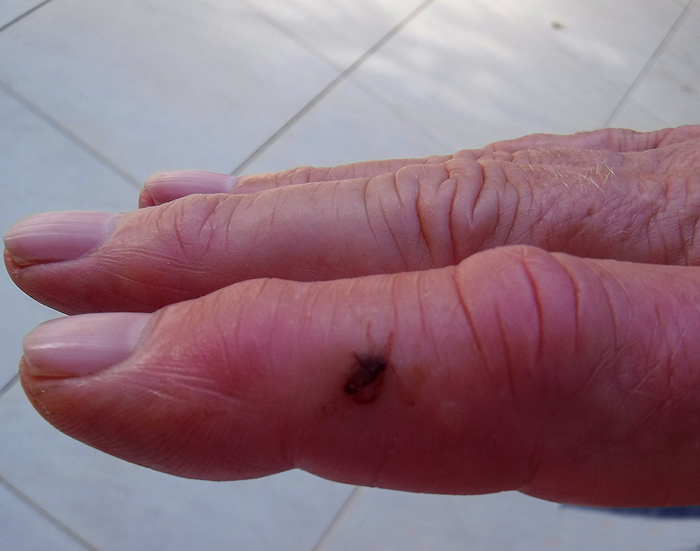

Catch Fish with
Mike Ladle
Information Page
SEA FISHING
For anyone unfamiliar with the site always check the FRESHWATER, SALTWATER and TACK-TICS pages. The Saltwater page now extends back as a record of over several years of (mostly) sea fishing and may be a useful guide as to when to fish. The Freshwater stuff is also up to date now. I keep adding to both. These pages are effectively my diary and the latest will usually be about fishing in the previous day or two. As you see I also add the odd piece from my friends and correspondents if I've not been doing much. The Tactics pages which are chiefly 'how I do it' plus a bit of science are also updated regularly and (I think) worth a read (the earlier ones are mostly tackle and 'how to do it' stuff).
The Sting!
I guess that all sea anglers have heard of fish that sting. Here in the UK we have greater and lesser weevers with their little black flag fins to warn off any unwary predators. Sting rays and spur dogs are also catches which need to be handled with care. In the tropics there are lots more dangerous creatures including lionfish and stonefish and their relatives, a jab from which may cause a lot of distress if not actual death. Of course less experienced fishermen may think that all spiky fish are dangerous so it is not unusual to see youngsters and novice anglers killing things such as sea scorpions and other 'ugly' catches in the belief that they may be dangerous (which they aren't).
Almost eighteen months ago, while visiting my son Richard in Brazil I was stung by the spiny pectoral fin of a small silver catfish. I can't say that I hadn't been warned so it was my own fault for being careless as I shook the hook out of my catch. Richard said it would hurt and I hate to admit that he was right - it was excruciating. Anyway, to come to the point, I've always been pretty cavalier about handling my catches and over the years I've been bitten or stabbed by quite a few of our marine species with nothing more than a spot of blood or a shortlived discomfort to show for it. So, to come to the point, the other day I had an email from Kevin Thornton and it went as follows -
"Hi Mike,
Like me, you would have pricked your fingers on bass and bream spines many times so I thought you may be interested in what follows. Yesterday, after a successful day at sea, I was emptying the catch box, I stuck my finger on a black bream spine. Iím not sure what fin was the culprit but it hurt like hell. After an hour or so, the pain was still quite bad so I squeezed my finger to push out some blood. Some blood did appear but what surprised me was a thin black strand of silk like material which came out of the hole. I pulled it out. It was about 5mm long. Once out, the pain reduced considerably. Iíve had many such stabbings over the years and noticed how long they take to heal but never seen this black thread before. Iím wondering if it is a sting, a toxic defence, that bream and maybe bass have? After all, they don't have sharp spines for nothing do they?
Any thoughts?
Best regards,
Kevin
I replied as follows -
Thanks for the email. It wouldn't surprise me in the least if some of our prickly fish have nasty poisonous mucous, although I can't say that any of my (many) fish spine injuries has caused me that much pain (except the marine catfish sting that I had in Brazil well over a year ago. I still have the lump on my finger and the pain was intense for a long time (days)). These toxic slimes etc. have to evolve at some point, so I guess bass or bream populations might find them useful once they had become fixed in the population. Maybe you caught a mutant or even the beginning of a new trait in bream biology. I suppose the other alternative could be some sort of bacterial or similar infection but I like the other story best. Has it healed up yet? Brazilian catfish seem to be crap baits so I guess it works for them.
Kevin wrote again saying -
"Hereís a pic of the hole in my finger. Not as spectacular as yours but it still hurts like blazes if I touch it. Even after removing a deep splinter of wood the pain doesnít last this long. My fishing mate rammed a bream spine right down the inside of his thumb nail a few years ago and even now, he cries when he thinks of it. We need some further research on bream and bass venom. Best wishes and keep on casting.
... again I replied -
I'll leave the research to you, I'd probably croak before I came to a conclusion. It is interesting though isn't it? I've never looked into what the active ingredient(s) of the venom are but I believe that some of them include intense, pain producing elements. It probably has to be powerful to deter predatory fish. I'll ask about and see if I can find out the facts. Perhaps all fish slime has the potential to do this.
I wondered if the catfish had left a bit of spine in me but I don't think so. Years ago my pal Terry broke a bass spine in his finger and weeks later it emerged from his elbow. Ugh! He didn't say it was particularly painful.
Kevin wrote again saying -
Thanks Mike,
Maybe, just maybe, thereís a lot more fish out there, other than weevers, lion and stone fish that pack a punch. It really is a hostile world under the waves so it seems to me, many fish may have a few more tricks up their sleeves to stay ahead of the curve.
Now I come to think of it, have you ever noticed how long it takes for your fingers to heal if you have scratched them on the teeth of a channel whiting? Iíve heard it said their teeth are coated with something, bacteria maybe, which prevents scratches from their needle sharp teeth from healing. It sounds highly likely but this wouldnít offer any immediate benefit to a whiting, and if this is so, itís probably just a case of bacteria hitching a ride. But remember, we also thought this was the case with Komodo dragons. Weíve recently discovered they actually possess venom to kill their prey, and not bacteria. Who knows?
You wrote in Hooked On Bass, or was it Alan, that small wrasse are often taken by bass. Well wrasse also have sharp dorsal spines but they donít seem to offer much protection against getting eaten. So assuming bream are also eaten by predators, despite their sharp fins, I am now wondering if they are indeed evolving, or have evolved a secondary defence mechanism in the form of venom or toxic slime? I am in no doubt the thread I pulled out of my finger came from the spine of a bream, so it would appear to have been injected. What surprises me is that what I pulled out would appear to be more like a bee sting rather than liquid venom.
I squeezed my finger and out popped a millimetre or so of the black silk like thread. This thread was clearly visible. It stood out black against the blue sky as I held my finger up. (actually, Iím quite colour blind but the thread was very dark, either black or brown I guess) I showed it to my fishing mate and together we looked in awe as I pulled the rest of it out with finger and thumb. Our catch was in a large plastic cool box. What came out of my finger could only have come from the spine of a bream.
Iím still perplexed, and incidentally, still in pain! Be great to hear if anyone else has had such an experience.
So, HAS ANYONE ELSE HAD NAST EXPERIENCES WITH BREAM (or bass or what have you)? Drop me a line if you have.
Catfish sting - still uncomfortable.

Bream sting? Doesn't look much but hurts.

Ė PLEASE TELL YOUR TWITTER, FACEBOOK, EMAIL FRIENDS ABOUT THESE BOOKS.
BRAND NEW BOOK
"Fishing for Ghosts - Successful Mullet Angling"
written with David Rigden IT'S AVAILABLE FROM -ALSO THE NEW BOOK
ďThe Second WaveĒ
Written with Steve Pitts this is a SEQUEL TO THE BESTSELLER "Operation Sea Angler" IT'S AVAILABLE ON PAPER OR FOR YOUR KINDLE FROM -If you have any comments or questions about fish, methods, tactics or 'what have you!' get in touch with me by sending an E-MAIL to - docladle@hotmail.com